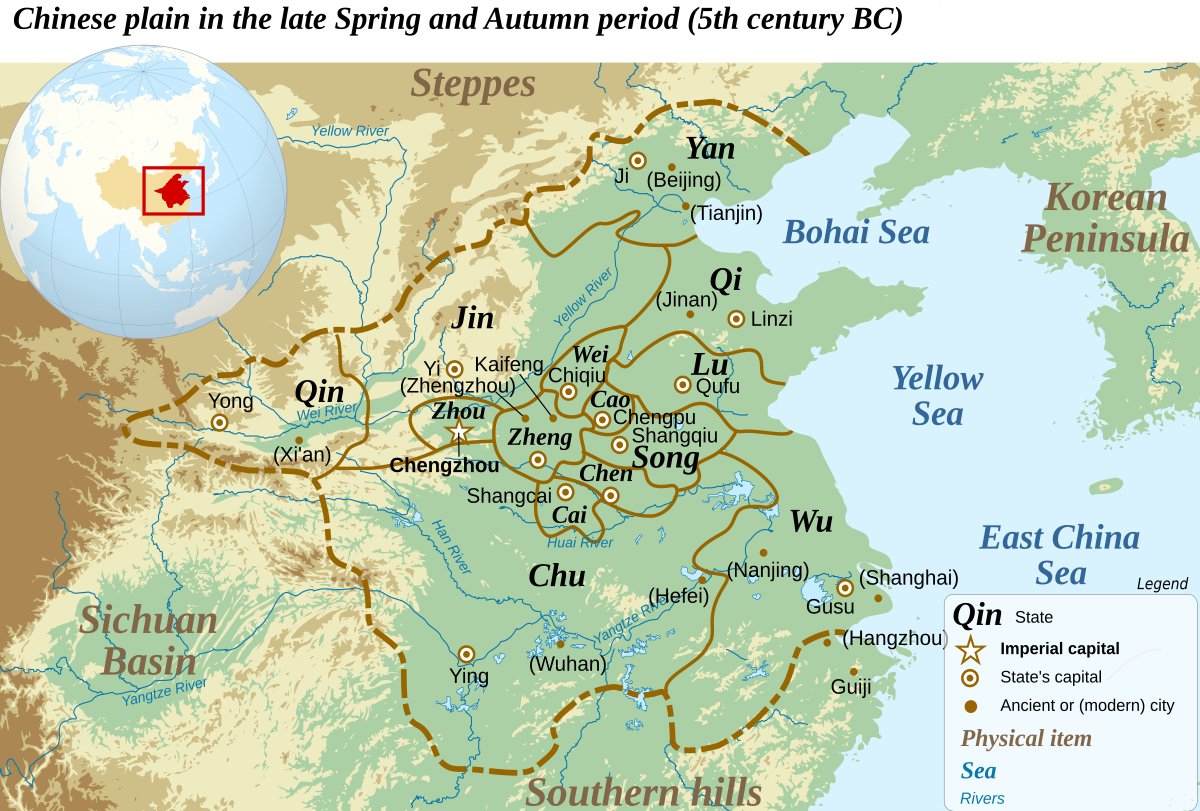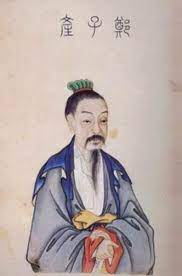
Former U.S. Army China Foreign Area Officer. Currently studying and writing about ancient Chinese strategic texts. Climber of Mt. Villingili.
4 subscribers
How to get URL link on X (Twitter) App



 Ever since Sun Tzu first entered the West’s consciousness, we have mainly focused on situating it within Howard’s concept of WIDTH: “an observation of the way in which warfare has developed over a long historical period.” Most famously B.H. Liddell Hart, despite not having …
Ever since Sun Tzu first entered the West’s consciousness, we have mainly focused on situating it within Howard’s concept of WIDTH: “an observation of the way in which warfare has developed over a long historical period.” Most famously B.H. Liddell Hart, despite not having …

 Ge notes that early Chinese writing lacked a general category term for agricultural products like the modern term “crops” (莊稼), so when referenced in early texts the authors would need to use the character for the specific type of crop being discussed: rice, millet, wheat, etc.
Ge notes that early Chinese writing lacked a general category term for agricultural products like the modern term “crops” (莊稼), so when referenced in early texts the authors would need to use the character for the specific type of crop being discussed: rice, millet, wheat, etc. 

 Much like Lykke’s 3-legged stool remains the basis for defining strategy in western PME the 2020 SMS argues: “in terms of the essential characteristics and functions of strategy, the three elements are indispensable and should be considered the fundamental components of strategy”
Much like Lykke’s 3-legged stool remains the basis for defining strategy in western PME the 2020 SMS argues: “in terms of the essential characteristics and functions of strategy, the three elements are indispensable and should be considered the fundamental components of strategy” 

 casualties among its officers and soldiers is a weakness that will persist for a long time, especially when the U.S. military conducts large-scale aggressive wars overseas. This fear of casualties will intensify."
casualties among its officers and soldiers is a weakness that will persist for a long time, especially when the U.S. military conducts large-scale aggressive wars overseas. This fear of casualties will intensify."

 Although Andrew did not footnote this claim, an interview published in 1968 documents this fascinating exchange between Mao Zedong and Lin Biao (the man soon after labeled traitor of the revolution) where they do discuss the Chairman’s level of exposure to Sun Tzu’s Art of War.
Although Andrew did not footnote this claim, an interview published in 1968 documents this fascinating exchange between Mao Zedong and Lin Biao (the man soon after labeled traitor of the revolution) where they do discuss the Chairman’s level of exposure to Sun Tzu’s Art of War. 

 the larger Zhou kingdom, strategically located but perilously wedged between two more powerful and predatory feudal states, Jin and Chu. Zichan was a skilled diplomat, an early prototype of later celebrated statesmen like Metternich and Kissinger, who worked tirelessly to protect
the larger Zhou kingdom, strategically located but perilously wedged between two more powerful and predatory feudal states, Jin and Chu. Zichan was a skilled diplomat, an early prototype of later celebrated statesmen like Metternich and Kissinger, who worked tirelessly to protect 

 Sima Qian noted that in 215 BC the first emperor, Qin Shihuang, dispatched Scholar Lu to seek out the immortals in hopes of finding a key to longevity. When Lu returned, he claimed he met the immortals beyond the sea, who relayed to him the message: “Qin will be destroyed by Hu”
Sima Qian noted that in 215 BC the first emperor, Qin Shihuang, dispatched Scholar Lu to seek out the immortals in hopes of finding a key to longevity. When Lu returned, he claimed he met the immortals beyond the sea, who relayed to him the message: “Qin will be destroyed by Hu” 

 Well before Pearl Harbor, the US had been supporting Chiang Kai-shek's war with Japan, but US interlocutors were getting frustrated that the KMT was more focused on preparing against the CCP than fighting the Japanese. Theodore White, a famous journalist, interviewed him in 1941
Well before Pearl Harbor, the US had been supporting Chiang Kai-shek's war with Japan, but US interlocutors were getting frustrated that the KMT was more focused on preparing against the CCP than fighting the Japanese. Theodore White, a famous journalist, interviewed him in 1941 

 For our historical example, we will examine Sparta's initial strategy during the Peloponnesian War. As described by Thucydides, the Spartans would annually march its army directly into Attica, purposefully avoiding besieging Athens, but destroying the Attic countryside.
For our historical example, we will examine Sparta's initial strategy during the Peloponnesian War. As described by Thucydides, the Spartans would annually march its army directly into Attica, purposefully avoiding besieging Athens, but destroying the Attic countryside. 

https://twitter.com/JohnF_Sullivan/status/1670429344458592256Following the Song army’s catastrophic defeat, there is a fascinating debate between Duke Xiang of Song and his military advisor, Ziyu. Even in defeat, the duke defends his decision to not urge an attack on Chu while they were severely disadvantaged due to factors of terrain.


 We will soon have a new ‘Exalted Documents’ (Nylan) and ‘Pheasant Cap Master’ (Goldin). A new ‘Discourse on Salt and Iron’ is in the works as well as two more Spring & Autumn commentaries: Gongyang & Guliang. We are also close to having the full version of Sima Qian’s Shiji.
We will soon have a new ‘Exalted Documents’ (Nylan) and ‘Pheasant Cap Master’ (Goldin). A new ‘Discourse on Salt and Iron’ is in the works as well as two more Spring & Autumn commentaries: Gongyang & Guliang. We are also close to having the full version of Sima Qian’s Shiji.



 He makes this clear in his 1938 work, Problems of War and Strategy: "In the anti-Japanese war as a whole, regular warfare is primary and guerrilla warfare is supplementary, for only regular warfare can decide the final outcome of the war." Mao identifies three strategic phases...
He makes this clear in his 1938 work, Problems of War and Strategy: "In the anti-Japanese war as a whole, regular warfare is primary and guerrilla warfare is supplementary, for only regular warfare can decide the final outcome of the war." Mao identifies three strategic phases... 

 Yet how many in the West will recognize these references let alone grasp what lessons contemporary Chinese leaders are drawing from them?
Yet how many in the West will recognize these references let alone grasp what lessons contemporary Chinese leaders are drawing from them?


 First is Fuxin (literally stomach and heart) An individual in charge of advising about secret plans for responding to sudden events; investigating Heaven so as to eliminate sudden change; exercising general supervision over all planning; and protecting the lives of the people.
First is Fuxin (literally stomach and heart) An individual in charge of advising about secret plans for responding to sudden events; investigating Heaven so as to eliminate sudden change; exercising general supervision over all planning; and protecting the lives of the people. 



 Failing that, nothing is better than harshness. Consider the flames of a fire: when they look at it, the people fear it, and therefore few die in it. But water is soft and yielding: the people play with it, feeling that it is familiar, and as a result many die in it.
Failing that, nothing is better than harshness. Consider the flames of a fire: when they look at it, the people fear it, and therefore few die in it. But water is soft and yielding: the people play with it, feeling that it is familiar, and as a result many die in it.

 What I like about the episode is that mankind—after initial skepticism—does not misjudge the aliens’ true intent solely on the ambiguously translated book title; they also misinterpret concrete actions from the aliens in a positive light which reinforces a belief in benign intent
What I like about the episode is that mankind—after initial skepticism—does not misjudge the aliens’ true intent solely on the ambiguously translated book title; they also misinterpret concrete actions from the aliens in a positive light which reinforces a belief in benign intent 

 Moreover, a more interesting comparison is not Sun Tzu and Lao Tzu, but instead Sun Tzu and Mo Tzu (Mozi). As I've been arguing, we should seriously consider that much of the Art of War's main thesis is a direct rejection of Mozi's defense oriented tactics
Moreover, a more interesting comparison is not Sun Tzu and Lao Tzu, but instead Sun Tzu and Mo Tzu (Mozi). As I've been arguing, we should seriously consider that much of the Art of War's main thesis is a direct rejection of Mozi's defense oriented tacticshttps://twitter.com/JohnF_Sullivan/status/1705742089630388630

 Prior to the writing of Sima Qian's magnum opus, "The Grand Scribe's Records," historical works followed a strict chronological format, meaning events were recorded sequentially by the year they occurred, like what is found in the Zuozhuan.
Prior to the writing of Sima Qian's magnum opus, "The Grand Scribe's Records," historical works followed a strict chronological format, meaning events were recorded sequentially by the year they occurred, like what is found in the Zuozhuan. https://x.com/JohnF_Sullivan/status/1678124310660259840?s=20

 Seventy-two Martial-Flanking Large Fuxu (扶胥) Chariots. They have 5-foot wheels and winch-powered linked crossbows which fire multiple arrows for self-protection. They are used to penetrate solid formations and defeat strong enemies.
Seventy-two Martial-Flanking Large Fuxu (扶胥) Chariots. They have 5-foot wheels and winch-powered linked crossbows which fire multiple arrows for self-protection. They are used to penetrate solid formations and defeat strong enemies. 